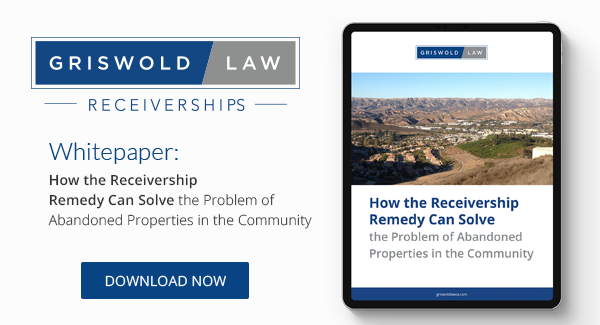The story of an abandoned property does not always start with the owner of the property packing up and walking away. Often, these properties belonged to someone who is now deceased and next of kin either can’t be found or doesn’t exist.
What Is an Abandoned Property and What Can Be Done?
But first, a definition: The legal definition of an “abandoned property” is a property that has been left behind permanently, and there is no intention for it to be used for any reason by the owner. An abandoned property can cause many problems for the community in which it sits. It not only lowers the property value of the homes nearby, but it can also be a magnet for crime or squatters.
Laws regarding addressing abandoned properties vary by state. Should an abandoned property become a nuisance in California, a receivership action can be initiated (under the recently revised California Health and Safety Code § 17980.7(c)) once they post the property with the “3 Day Notice” and mail it via first-class mail to all people and/or entities with a recorded interest. Three days after the posting and mailing of the notice, the enforcement agency can then file the receivership petition with the Court.
What Happens if the Property Owner Is Deceased?
Any type of abandoned property can become a problem in a community. However, when the property is abandoned due to the death of the owner, there are no owners for the enforcement agency to communicate with and give a reasonable amount of time to correct the matter. As a result, the burden falls to the city to attempt to secure the property for the safety of the larger community.
That’s when a receiver comes in. A receiver is a neutral third party who is appointed by the court to take control of the management and rehabilitation of the abandoned property. The receiver takes responsibility for developing a long-term plan that will ensure the property no longer serves as a nuisance in the community.
Once a court appoints a receiver, the receiver has the following duties:
- Manage the property
- Take care of the expenses of the property
- Obtain repair estimates
- Obtain funding through Receiver’s Certificates
- Supervise the rehabilitation of the property
- Supervise the potential sale of the property
Each step of the rehabilitation process is carefully overseen by a judge. While a receiver often takes the opinions and insights of the community to heart in the process, in the end, they are beholden to the courts alone. The receiver’s focus is to take control of a possibly uncontrolled situation and turn it around for the health and safety of everyone in the community.
Griswold Law and Receivership
Griswold Law has years of experience when it comes to navigating the sometimes complex system of health and safety laws when it comes to abandoned properties. Attorney Richardson “Red” Griswold is commonly appointed in California courts as a Receiver of properties that have been abandoned and have become a problem for the neighborhood.
Contact one of our professionals today to discuss options you have to legally resolve the issue of an abandoned property. Watch our video below to learn a little more about how receiverships can transform an abandoned property into something useful in the community.

